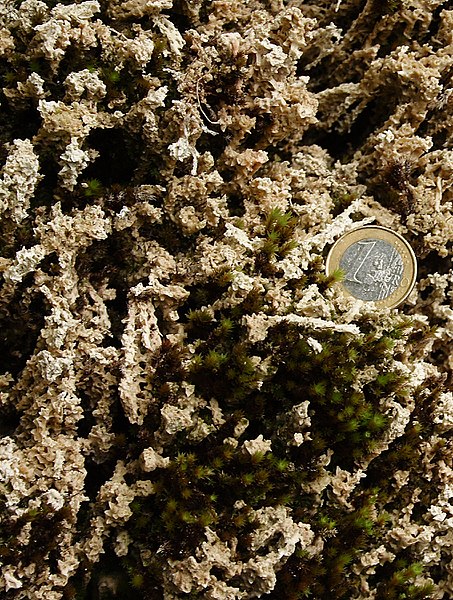File:Kalktuff-Mosscrusts.jpg

Original file (1,360 × 1,800 pixels, file size: 2.93 MB, MIME type: image/jpeg)
| This is a file from the Wikimedia Commons. The description on its description page there is shown below.
|

|
This image has currency in it to indicate scale.
Using coins for scale is discouraged as it will require people unfamiliar with them to look up the dimensions or guess, both of which defeat the purpose of the object in the first place. Coins can also reinforce a geographical bias, and some coins' designs are copyrighted. Ideally, a photograph should include a ruler with the subject (example) or an added scale marking. SI ("metric") units are the most commonly used worldwide (see meter and centimeter). Images with coins to indicate scaleCommon coin diameters for reference:
Deutsch ∙ English ∙ español ∙ français ∙ Gaeilge ∙ italiano ∙ Plattdüütsch ∙ português ∙ sicilianu ∙ svenska ∙ suomi ∙ македонски ∙ русский ∙ മലയാളം ∙ 한국어 ∙ 日本語 ∙ 中文 ∙ 中文(简体) ∙ עברית ∙ +/− |
| DescriptionKalktuff-Mosscrusts.jpg |
Deutsch: Kalktuff; frisches Wachstum am Albtrauf, Schwäbische Alb. Die Assimilation von Moos erhöht die Ausfällung von Calciumhydrogencarbonat aus dem Karstwasser einer Schichtquelle. Auf dem verkrusteten Moosgerüst wächst frisches Moos nach. Es entwickelt sich ein nach vorne und oben wachsendes, fragiles Gebilde.
Kalktuff gehört zur Gruppe der Sinter. English: Fresh Kalktuff („Calcarious Tuff") - a rare secondary deposit of solid calcium carbonate on the Swabian Alb and the Franconian Jura, southern Germany. Assimilation of Moss accelerates chemical precipitation of calcium bicarbonate, which is dissoluted in karst water. The moss grows freshly on top of its encrusted species. These iterations form fragile structures. |
| Date | |
| Source | see author |
| Author | Ustill |
| Permission (Reusing this file) |
for creative commons |
- You are free:
- to share – to copy, distribute and transmit the work
- to remix – to adapt the work
- Under the following conditions:
- attribution – You must give appropriate credit, provide a link to the license, and indicate if changes were made. You may do so in any reasonable manner, but not in any way that suggests the licensor endorses you or your use.
- share alike – If you remix, transform, or build upon the material, you must distribute your contributions under the same or compatible license as the original.

Captions
Items portrayed in this file
depicts
31 January 2008
File history
Click on a date/time to view the file as it appeared at that time.
| Date/Time | Dimensions | User | Comment | |
|---|---|---|---|---|
| current | 16:16, 31 January 2008 | 1,360 × 1,800 (2.93 MB) | Ustill | {{Information| |Description= {{de|Kalktuff; frisches Wachstum am Albtrauf, Schwäbische Alb. Die Assimilation von Moos erhöht die [[:de:Ausfällung|Ausfällung] |
File usage
The following page uses this file:
Metadata
This file contains additional information, probably added from the digital camera or scanner used to create or digitize it.
If the file has been modified from its original state, some details may not fully reflect the modified file.
| Camera manufacturer | Canon |
|---|---|
| Camera model | Canon EOS 350D DIGITAL |
| Author | wiki@ulrich-tichy.de |
| Copyright holder | CC-by-sa-2.0-de |
| Exposure time | 1/100 sec (0.01) |
| F Number | f/7.1 |
| ISO speed rating | 400 |
| Date and time of data generation | 16:14, 20 October 2006 |
| Lens focal length | 44 mm |
| Pixel composition | RGB |
| Orientation | Normal |
| Horizontal resolution | 72 dpi |
| Vertical resolution | 72 dpi |
| Software used | Adobe Photoshop CS2 Windows |
| File change date and time | 16:00, 2 January 2008 |
| Y and C positioning | Centered |
| Exposure Program | Shutter priority |
| Exif version | 2.21 |
| Date and time of digitizing | 16:14, 20 October 2006 |
| APEX shutter speed | 6.6438598632812 |
| APEX aperture | 5.6556396484375 |
| Flash | Flash did not fire, compulsory flash suppression |
| Color space | sRGB |
| Focal plane X resolution | 3,954.233409611 |
| Focal plane Y resolution | 3,958.7628865979 |
| Focal plane resolution unit | inches |
| Custom image processing | Normal process |
| Exposure mode | Auto bracket |
| White balance | Auto white balance |
| Scene capture type | Standard |